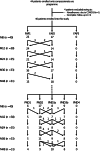Long-term treatment of hereditary transthyretin amyloidosis with patisiran: multicentre, real-world experience in Italy
- PMID: 38622453
- PMCID: PMC11306272
- DOI: 10.1007/s10072-024-07494-9
Long-term treatment of hereditary transthyretin amyloidosis with patisiran: multicentre, real-world experience in Italy
Erratum in
-
Correction to: Long-term treatment of hereditary transthyretin amyloidosis with patisiran: multicentre, real-world experience in Italy.Neurol Sci. 2025 Jan;46(1):519-520. doi: 10.1007/s10072-024-07717-z. Neurol Sci. 2025. PMID: 39090357 Free PMC article. No abstract available.
Abstract
Background: Hereditary transthyretin (ATTRv, v for variant) amyloidosis with polyneuropathy is a rare disease caused by mutations in the transthyretin gene. In ATTRv amyloidosis, multisystem extracellular deposits of amyloid cause tissue and organ dysfunction. Patisiran is a small interfering RNA molecule drug that reduces circulating levels of mutant and wild-type TTR proteins. Prior to its regulatory approval, patisiran was available in Italy through a compassionate use programme (CUP). The aim of this study was to analyse the long-term outcomes of patients who entered into the CUP.
Methods: This was a multicentre, observational, retrospective study of patients with ATTRv amyloidosis treated with patisiran. The analysis included change from baseline to 12, 24, 36 and 48 months in familial amyloid polyneuropathy (FAP) stage, polyneuropathy disability (PND) class, neuropathy impairment score (NIS), modified body mass index (mBMI), Compound Autonomic Dysfunction Test (CADT), Karnofsky Performance Status (KPS) scale and Norfolk Quality of Life-Diabetic Neuropathy (QoL-DN) questionnaire. Safety data were also analysed.
Results: Forty patients from 11 Italian centres were enrolled: 23 in FAP 1 (6 in PND 1 and 17 in PND 2) and 17 in FAP 2 (8 in PND 3a and 9 in PND 3b) stage. In this population, the mean NIS at baseline was 71.4 (± 27.8); mBMI, 917.1 (± 207) kg/m2; KPS, 67.1 (± 14.0); Norfolk QoL-DN, 62.2 (± 25.2); and CADT, 13.2 (± 3.3). Statistical analysis showed few significant differences from baseline denoting disease stability. No new safety signals emerged.
Conclusions: Patisiran largely stabilised disease in patients with ATTRv amyloidosis.
Keywords: Compassionate use programme; Hereditary transthyretin amyloidosis; Patisiran; Real-world.
© 2024. The Author(s).
Conflict of interest statement
Dr Luigetti received financial grants (honoraria and speaking) from Ackea, Alnylam, Sobi, and Pfizer, and travel grants from Ackea, Alnylam, Sobi, Pfizer, Kedrion and Grifols.
Dr. Gentile received financial grants (honoraria and speaking) from Akcea, Alnylam, and Pfizer, and travel grants from Alnylam and CSL Behring.
Dr. Mazzeo received speaker fees and consulting honoraria from Alnylam Pharmaceuticals, Akcea Therapeutics, and Pfizer Inc.
Dr. Manganelli has no conflict of interest to declare.
Dr Obici reports speaker and consulting honoraria from Pfizer, Alnylam, SOBI, Novo Nordisk, Astra Zeneca and BridgeBio.
Dr. Briani received speaker and consulting honoraria from Alnylam, Ionis, and Pfizer, and travel grants from Kedrion, Alnylam and CSL Behring.
Dr. Casagrande has no conflict of interest to declare.
Dr. De Luca received financial grants (speaking) from Pfizer, and travel grants to attend scientific meetings from Pfizer and SOBI.
Dr. Fabrizi received financial grants (honoraria and speaking) from Akcea, Alnylam and travel grants from Akcea, Pfizer and Kedrion.
Dr. Gagliardi received financial grants (consulting and speaking) from Pfizer and Alnylam.
Dr. Gemelli received financial grants (speaking) from Italfarmaco, and travel grants from Biogen for participation in national meetings.
Dr. Forcina has no conflict of interest to declare.
Dr. Grandis acknowledges donations from Sanofi Genzyme to support research activities of her Research Unit. Financial support from Pfizer, Alnylam and Sanofi Genzyme for participation in National and International Meetings. Participation in Advisory Board of Pfizer and Argenx. Speaker honorarium from Sanofi Genzyme and Alexion.
Dr. Guglielmino has no conflict of interest to declare.
Dr. Iabichella received travel grants to attend scientific meetings from Alnylam and SOBI.
Dr. Leonardi received financial grants (honoraria and speaking) from Alnylam, and travel grants to attend scientific meetings from Akcea, SOBI, Alnylam.
Dr. Lozza has no conflict of interest to declare.
Dr. Mussinelli received financial grants (speaking) from Pfizer and SOBI, and travel grants to attend scientific meetings from Alnylam.
Dr. My received financial grants (honoraria and speaking) from Alnylam, and travel grants to attend scientific meetings from Alnylam.
Dr. Occhipinti has no conflict of interest to declare.
Dr. Fenu acknowledges financial support from Alnylam and Pfizer for participation in national and international meetings.
Dr. Russo has no conflict of interest to declare.
Dr. Romano received financial grants (honoraria and speaking) from Akcea, and travel grants to attend scientific meetings from Akcea, Alnylam, Pfizer, and Csl Behring.
Dr. Salvalaggio received travel grant to attend scientific meeting from Alnylam.
Dr. Stefano Tozza received personal fees for scientific events from Alnylam Pharmaceuticals, Amicus Therapeutics and Takeda Pharmaceutical Co, travel grants to attend scientific meetings from Akcea Therapeutics.
Figures
References
-
- Luigetti M, Romano A, Di Paolantonio A, Bisogni G, Sabatelli M (2020) Diagnosis and treatment of hereditary transthyretin amyloidosis (hATTR) polyneuropathy: current perspectives on improving patient care. Ther Clin Risk Manag 16:109–123. 10.2147/TCRM.S219979 10.2147/TCRM.S219979 - DOI - PMC - PubMed
-
- Adams D, Coelho T, Obici L, Merlini G, Mincheva Z, Suanprasert N, Bettencourt BR, Gollob JA, Gandhi PJ, Litchy WJ, Dyck PJ (2015) Rapid progression of familial amyloidotic polyneuropathy: a multinational natural history study. Neurology 85(8):675–682. 10.1212/WNL.0000000000001870 10.1212/WNL.0000000000001870 - DOI - PMC - PubMed
Publication types
MeSH terms
Substances
Supplementary concepts
LinkOut - more resources
Full Text Sources
Research Materials
Miscellaneous


